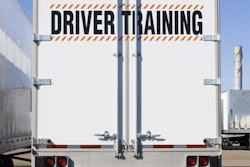
Less robust vehicle components such as floorboards, fenders and doors can be the first structures to fail due to corrosion. Today, with new trucks more dependent on sensitive and vulnerable electronic connections and wiring harnesses, corrosion can bring a truck to a dead stop even quicker.
“We try to have our equipment washed once a week at our terminals,” says Michael Burns, vice president of Burns Motor Freight of Marlinton, W.Va. However, Burns warns that quick washes won’t prevent all corrosion because chemicals such as magnesium chloride and road salts lay in frames, junction boxes, upper couplers and other hard-to-clean areas.
“Over time, corrosion starts to rear its ugly head by having more electrical shorts, paint flaking and pits in metal,” he says. “I’ve seen shocks completely disappear due to corrosion, even with a weekly washing.”
[gtblockquote quote_text_size=”16″ quote_text_style=”normal” quote_text_color=”#ADADAD” border_size=”4″ border_color=”#E6E6E6″]“I’ve seen shocks completely disappear due to corrosion.” – Michael Burns, vice president, Burns Motor Freight
Russ Whiting, president of Whiting Systems Truck Washes, says one simple way to control corrosion is by cleaning a vehicle thoroughly on a frequent basis to remove contaminants before they can do serious damage. Like Burns, Whiting warns that just washing a truck’s exterior is not enough.
“You really need a comprehensive washing system that washes the undercarriage, chassis and as many hard-to-reach areas on the vehicle as possible,” he says. “Nothing else is as effective as stopping corrosion before it starts than washing. You cannot stop corrosive materials from getting onto a vehicle, particularly in winter months, but you can limit the amount of time they are on a truck and the amount of damage they do.”
Brett Johnson, president and chief executive officer of Optronics International, says corrosion most often is caused by moisture intrusion within a vehicle’s electrical and power delivery system. “The chemicals used to treat the roads can accumulate on the equipment via road spray and will eventually ‘infect’ the components on a piece of equipment, including the electrical system,” he says.
Chemical-based corrosion is prevalent on trailers because the harness system typically is exposed to the elements, Johnson says. Once corrosion begins, an electrical and wiring system can be compromised quickly through leaking lamp connections, cracked lamp housings and lenses, wire and cable abrasion, grit and sand damage, extreme temperature fluctuations, extensive flexing and exposure to moving parts.
Burns’ fleet pays attention to frames, starters, battery terminals, junction boxes, electronic control module connections, ABS components/sensors, electrical terminals, radiators, shock absorbers, frame brackets, brake shoes and slack adjustors – “virtually any component that is exposed to these chemicals,” he says.
“We pay extra to have our truck OEM spray a corrosion protectant on electrical components,” says Burns. “We also pay a higher cost for our trailers because we spec the best paint to resist these chemicals.”
In addition to washing and protective coatings, maintenance basics can go a long way toward controlling corrosion. “We stress that technicians make corrosion awareness a routine part of their maintenance checks,” says Dennis Dammon, national accounts manager for Phillips Industries, a manufacturer of electrical and air brake components.
Routine checks should include major electrical connections, including batteries, starters and alternators. “Make sure no corrosion is present, and treat all major external connections with a corrosion-protective covering,” Dammon says.









